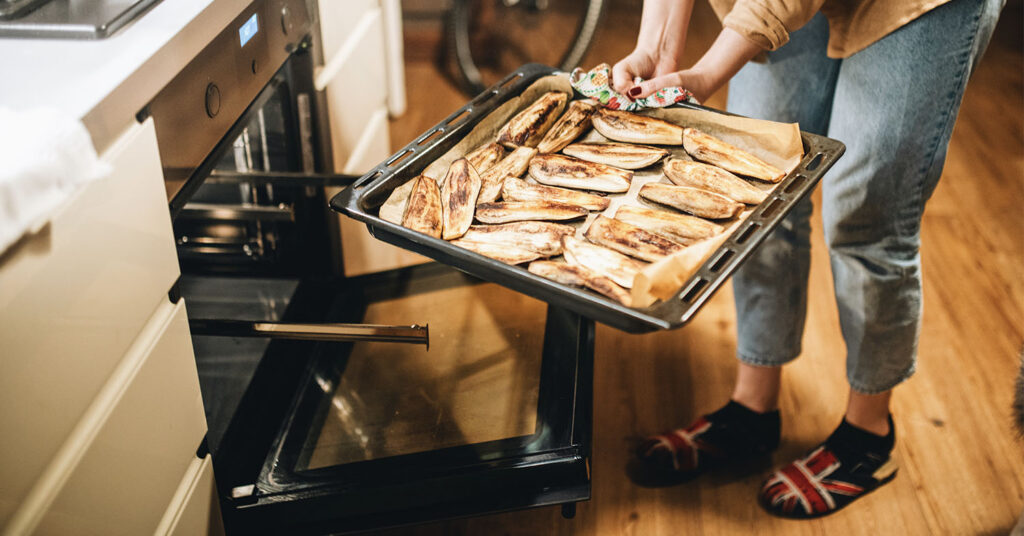There are a few things that I’ve learned about time in the time I’ve spent on this planet. The first one is that once it’s spent, you never get it back. The second is that it never stops. And the third is that you always have a lot less of it than you think you do. Between balancing work, a social life, a (maybe someday) regular workout schedule, cleaning, and time for self-care, I need to find time to eat. And unless I want to blow through a month’s food budget on takeout in a week, it needs to be cooked.
Enter the sheet pan dinner. Put your Instant Pots, colorful non-stick pans, air fryers, and Cuisinart mixers to the side for now. It’s been a tough year and a half, so this fall’s most versatile, practical, and space-saving tool requires no instruction manual. It’s also one you probably already have in your kitchen that didn’t cost you more than $20: a sheet pan. I spoke to James Beard-nominated cookbook author and recipe developer Raquel Pelzel, all about why your sheet pan really needs to be your new favorite kitchen companion. As the author of “Sheet Pan Suppers Meatless: 100 Surprising Vegetarian Meals Straight from the Oven,” Pelzel knows a thing or two about this humble piece of cookware.
Like your pressure cooker or air fryer, a sheet brings convenience. Not just for a busy pet parent of two rescues (*raises hand* Hi, that’s me.) but also for parents of humans.
Pelzel, who has two (human) kids and works full-time, has a deep appreciation for using sheet pans to make her life easier. “We’re all so stressed out and maxed out and so much is happening in the world, I think it’s nice to have something really healthy and delicious in little time,” says Pelzel.
Unlike cooking vegetables in a roasting pan, everything on your sheet pan is exposed to the heat, so things cook fast. Meals can be done in 15 to 45 minutes or less. And there’s a lot more to sheet pans than quick dinners with easy clean-ups. Pelzel says the aluminum sheet pans are “super conducive,” so building flavor through caramelization and browning just happens. (As opposed to 45 minutes for caramelizing onions. They’re delicious, though.)
You can even cook rice on a sheet pan. According to Pelzel, cooking grains on a sheet pan is super forgiving. (Learn how to do it in this Brown Rice Bowl with Maple-Roasted Parsnips.) “So many people cook quinoa, and it ends up being very soggy and on a sheet pan, it’s just not. It cooks up beautifully, it’s super fluffy. The same with rice. It’s unexpectedly wonderful.”
Here are a couple of tips for cooking with a sheet pan:

Preheat the sheet pan to make meals in even less time
Preheating your sheet pan in the oven pays off in a few ways. First, it helps cut down on roasting time because the cookware is already hot when you add vegetables to it. And, it helps vegetables brown beautifully. Pelzel recommends trying it with broccoli—preheat the oven for 425 degrees Fahrenheit with the sheet pan already inside, toss broccoli with a little bit of olive oil and salt, throw it on the pan (it will sizzle), and roast it for 15 minutes, until it’s tender and charred.
You don’t really need to line the pan
There is a time and a place to use parchment paper or silicone baking mats—and in most cases, it has to do with dessert. But if your meal is on the savory side, skip the Silpat. “I throw stuff directly on the sheet pan and then when you go to stir or scrape it up with a spatula or wooden spoon, you get all that flavor that’s on the bottom of the pan up into the dish,” says Pelzel.
Of course, if you want clean-up to be even easier that night, then line your pan.

The color of your sheet pan matters
Sheet pans come in light and dark colors and they both deliver different results. For sheet pan recipes, use a lighter, aluminum pan. “Just like if you wear a black t-shirt in summer, you’ll be hotter than if you wore a white t-shirt because it absorbs more hear. So the same is true with the pan. You’ll have more browning and potentially burn stuff if you use a darker color sheet pan,” says Pelzel.
Use tools that make prep even easier
Sheet pan meals, by virtue, are quick to prep. Make that prep even easier by keeping a few key things in your utensil drawer, like a sharp chef’s knife and a sturdy cutting board. Pelzel swears by a microplane grater, which can not only zest citrus, and grate whole nutmeg, but also grate garlic. “When I don’t have one, I always miss it,” she says.
Save your fancy olive oil for finishing
While Pelzel loves extra virgin olive oil, for roasting, she saves the fancy stuff for finishing. “At super high temperatures the flavor compounds break down,” she says. When it comes to roasting, olive oil with a lower price tag will do just fine. Canola or grapeseed will do, too. Then, hang on to that expensive olive oil for drizzling over pasta, rice bowls, stuffed vegetables, and more.
LIVEKINDLY is here to help you navigate the growing marketplace of sustainable products that promote a kinder planet. All of our selections are curated by the editorial team. If you buy something we link to on our site, LIVEKINDLY may earn a commission.


